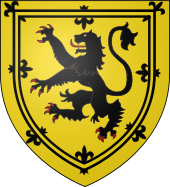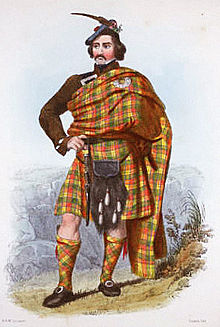- Clan Buchanan
-
Clan Buchanan Crest badge 
Crest: Or, a lion rampant Sable, armed and langued Gules, within a double tressure flory counterflory of the Second Motto: Clarior hinc honos or “Henceforth forward the honour shall grow ever brighter” War cry: Clar Innes[1] Profile District Stirling Plant badge Bilberry[citation needed] Gaelic name Macauselan,[citation needed] Cononach[citation needed] and Buth Chanain[citation needed] Chief Clan Buchanan has no chief, and is an armigerous clan 
Arms of the last Chief of Clan Buchanan Last Chief: Buchanan of Spittal[2] Clan branches Arnprior, Auchmar, Carbeth, Leny, Spital Clan Buchanan is an Armigerous Scottish clan whose origins are said to lie in the 1225 grant of lands on the eastern shore of Loch Lomond to clergyman Sir Absalon of Buchanan by the Earl of Lennox.[3]
Contents
History
Origins
Traditionally, Clan Buchanan can trace its origin back to Anselan O Kyan who was a son of the King of Ulster who landed in Argyll in 1016.[4] For his services against the Danes he received the lands of Buchanan, which lie to the east of Loch Lomond around the village of Killearn.[5]
Clan Buchanan has occupied the lands surrounding the shores of Loch Lomond since 1225 as a result of a grant by the Earl of Lennox to Sir Absalon of Buchanan in which he is referred to as 'clericus meus', meaning 'my clergyman'. Towards the middle of the 13th century Gilbert seneschal to the Earl of Lennox obtained part of the lands of Buchanan in Stirlingshire and took his surname from the lands called Buchanan.[3]
 A romantic depiction of a clansman illustrated by R. R. McIan, from James Logan's The Clans of the Scottish Highlands, 1845.
A romantic depiction of a clansman illustrated by R. R. McIan, from James Logan's The Clans of the Scottish Highlands, 1845.
Wars of Scottish Independence
During the Wars of Scottish Independence the Clan Buchanan supported King Robert the Bruce fighting at the Battle of Bannockburn and securing their lands.[citation needed]
15th century and clan conflicts
Sir Alexander Buchanan, Chief of Clan Buchanan, led men of the clan in support of the French against the English at the Battle of Baugé in 1421. It is said that Sir Alexander Buchanan came face to face with the Duke of Clarence and, escaping his thrust, pierced the Duke through the left eye, killing him.[3] Sir Alexander Buchanan however was later killed leading the clan against the English at the Battle of Verneuil in 1424.[3]
In the 15th century a feud broke out between the Clan Buchanan and the Clan MacLaren resulting in a full scale battle.[citation needed] At first the Buchanans were faring better and drove the MacLarens back.[citation needed] Legend has it that the Chief of MacLarens saw one of his sons cut down and being suddenly seized with battle madness turned and shouted the MacLaren battle cry "Craig Turic" and whirling his claymore rushed furiously at the enemy.[citation needed] His clansmen followed him and the Buchanans were cut down like corn.[citation needed] Only two escaped by swimming the River Balvaig but even they were followed.[citation needed] One was cut down at Gartnafuaran and the second was cut down at a place since known by the circumstance as Sron Laine.[citation needed]
In 1497 Kenneth Mackenzie, 8th of Kintail, chief of Clan Mackenzie was killed by the Laird of Buchanan.[6]
 Modern Tartan
Modern Tartan
16th century and Anglo-Scottish Wars
During the Anglo-Scottish Wars the Clan Buchanan fought against the English at the Battle of Flodden Field in 1513 where the chief's elder son Patrick was killed. However Patrick had already married a daughter of the Earl of Argyll and had two sons and daughters.[3]
Later the Clan Buchanan fought against the English at the Battle of Pinkie Cleugh in 1547 where their chief was killed.[citation needed] Clan chiefs from Clan Colquhoun, Clan Hunter, Clan MacFarlane and Clan Farquharson also died.[citation needed] A good clan chief was expected to lead by example and this meant being first into battle.[citation needed]
King of Kippen
John Buchanan became proprietor of Arnprior, and afterwards the noted "King of Kippen", a phrase which originated in a whimsical episode between himself and James V, who was fond of travelling in disguise under the title of "The Good Man of Ballageigh"[7][8], after the steep path leading down from the Castle of Stirling.
Demanding admittance at the palace of Arnprior, he was refused by a camp-looking warrior standing at the gate with a battle-axe sloped on his shoulder, who told him there was no admission, as his chief was at dinner with a large company and could not be disturbed at that time. "Tell your master," said James, "the Guidman o' Ballengeich humbly requests an audience of the 'King of Kippen'." Buchanan, guessing the quality of his guest, received His Majesty with the appropriate honours, and became so great a favourite that he had leave to draw upon the carrier as often as he pleased, and was invited, as "King of Kippen" to visit his brother sovereign at Stirling.
17th century and Civil War
During the Civil Wars Clan Buchanan supported the Royalist cause of King Charles. Sir George Buchanan commanded the Stirlingshire Regiment and led the clan at the Battle of Dunbar (1650) on the side of the Scottish Covenanters.[9] He later led the clan at the Battle of Inverkeithing but here he was captured and died in captivity later the same year.[9]
The Buchanans fought on the side of the Covenanters at the Battle of Bothwell Brig in 1679.
18th century and Jacobite uprisings
The Clan Buchanan took no part in the Jacobite uprisings of 1715 to 1716 or the 1745 to 1746 uprising.[citation needed] This was probably due to several reasons including their proximity to the land of the more powerful Campbells who fought with the Hanoverians and a break in the line of the chieftainship of the clan.[citation needed]
However, several members of Clan Buchanan fought at Culloden in the Duke of Perth's Regiment. Two individuals documented are: 1) Alexander Buchanan, born 1728, son of the Laird of Auchleishie, Callander, Perthshire, Sterlingshire, Jacobite Captain in the Duke's Regiment, prisoner at Perth, Canongate, Carlisle, ship, and London, transported 22 April 1747 from Liverpool to the Colony of Maryland on the ship "Johnson"[10], 2) John Buchanan, servant to Alexander Buchanan, resident of Auchterarder, Perthshire, Jacobite in the Duke's Regiment, prisoner at Auchterarder, Stirling, Carlisle, transported 24 Feb 1747 on the ship "Gildart" to the Colony of Maryland.[11]
Castles
Castles and seats of the Clan Buchanan have included: Buchanan auld House, Buchanan Castle (not the current castle but one destroyed in the 19th century), Buchanan Monument at Killearn, Craigend Castle, Dunglass Castle (Dunbartonshire), Northbar House, Francis Fort and Wolfshire Manor.
Branches
Arnprior, Auchmar, Carbeth, Leny, Spital
Septs
The Septs of Clan Buchanan derive from the first Auselan to use the surname Buchanan, Gilbert, whose father had obtained the Buchanan lands, and his brothers Colman and Methlan, grandson Maurice, and great-grandson Walter.[12]
Colman*,Cormack*, Cousland*, Dewar*, Dove*, Dow*, Dowe[citation needed], Gibb*, Gibbon*, Gibson*, Gilbert, Gilbertson*, Harper*, Harperson*, Leavy*, Lennie*, Lenny*, MacAldonich*, MacAlman*, MacAslan*, MacAslin*, MacAuselan*, MacAuslan*, MacAusland*, MacAuslane*, MacAlman*, MacAlmont*, MacAmmond*, MacAsland*, MacChruiter*, MacColman*, MacCormack*, MacCubbin*, MacCubbing*, MacCubin*, MacGeorge*, MacGibbon*, MacGreuisich*, MacGubbin*, MacInally*, MacIndeor*, MacIndoe*, MacKinlay*, MacKinley*, MacMaster*, MacMaurice*, MacMurchie*, MacMurchy*, MacNeur*, MacNuir*, MacNuyer*, MacQuattie*, MacWattie*, MacWhirter*, Masters*, Masterson*, MacCaslin*, Morrice*, Morris*, Morrison*, Murchie*, Murchison*, Richardson*, Risk*, Rusk*, Ruskin*, Spittal*, Spittel*, Walter*, Walters*, Wason*, Waters*, Watson*, Watt*, Watters*, Weir*, Yuill*, Yool*, Yule*, Zuill*.
- Asterisked (*) sept names are sourced from Scots Kith & Kin. 1900. Edinburgh: Albyn Press, Ltd. for Clan House, Lindsay & Co. Ltd., s.d. (c1960, reprint of 1900 first edition). 94 pp. + fold-out map.
See also
the sept masterson was irish, the scottish sept of Buchanan is spelt Masterton.[citation needed]
- Buchanan (surname) for a list of famous Buchanans
- Armigerous clan
- Scottish clan
Notes
- ^ The Scottish Clans and Their Tartans, p.11. (Retrieved on April 24, 2009). Edinburgh: W. & A.K. Johnston, 1900(?).
- ^ clanchiefs.org
- ^ a b c d e "The Scottish Clans and Their Tartans". W. & A. K. Johnston Limited. Edinburgh and London. 1886. Page 3.
- ^ Robert Bain. 1938. The Clans and Tartans of Scotland. Glasgow and London: Fontana/Collins. p. 50.
- ^ Bain, loc. cit.
- ^ "A History of the Clan Mackenzie" by Alexander MacKenzie.
- ^ Burke, Bernard (1849). Anecdotes of the Aristocracy: And Episodes in Ancestral Story (2 ed.). Henry Colburn. pp. 74–5. http://books.google.com/?id=o5oBAAAAQAAJ&pg=PA74
- ^ Also "The Gudeman of Ballangeich," e.g., "…Balangeich (the "windy pass"), a narrow path much used by James V., and from which he gave himself the name of "the Gudeman of Ballangeich," when he wanted an alias' — see Handbook for Travellers in Scotland, Third and Thoroughly Revised Edition with Travelling Maps and Plans. London: John Murray, Albemarle Street, printed by William Clowes and Sons, Stamford Street and Charing Cross; Edinburgh: Oliver & Boyd; Dublin: W. H. Smith & Son, 1873, p. 160.
- ^ a b Anderson 1862, p. 461.
- ^ "Prisoners of the '45.2.58," Muster Rolls of Prince Charles Edward Stuart's Army 1746.67, Public Records Office, London T1.328.
- ^ "Prisoners of the '45.2.60," Muster Rolls of Prince Charles Edward Stuart's Army 1746.69, Public Records Office, London T1.328.
- ^ Scots Kith & Kin. 1900. Edinburgh: Albyn Press, Ltd. for Clan House, Lindsay & Co. Ltd., s.d. (c1960, reprint of 1900 first edition). 94 pp. + fold-out map.
References
- Anderson, William (1862). The Scottish Nation: Or, The Surnames, Families, Literature, Honours, and Biographical History of the People of. Fullarton. p. 461. ISBN 0788403109.
External links
- http://www.buchanansociety.com
- http://www.scotclans.com/clans/Buchanan/history.html
- http://www.electricscotland.com/webclans/atoc/buchana2.html
Scottish clans Clans with chiefs Agnew · Anstruther · Arbuthnott · Arthur · Bannerman · Barclay · Borthwick · Boyd · Boyle · Brodie · Broun · Bruce · Buchan · Burnett · Cameron · Campbell · Carmichael · Carnegie · Cathcart · Charteris · Chattan · Chisholm · Cochrane · Colquhoun · Colville · Cranstoun · Crichton · Cumming · Darroch · Davidson · Dewar · Drummond · Dunbar · Dundas · Durie · Elliot · Elphinstone · Erskine · Farquharson · Fergusson · Forbes · Forsyth · Fraser · Fraser of Lovat · Gayre · Gordon · Graham · Grant · Gregor · Grierson · Guthrie · Haig · Haldane · Hamilton · Hannay · Hay · Henderson · Home · Hope · Hunter · Irvine · Jardine · Johnstone · Keith · Kennedy · Kerr · Kincaid · Lamont · Leask · Lennox · Leslie · Lindsay · Lockhart · Lumsden · Lyon · MacAlister · MacBain · MacDonald · Macdonald of Clanranald · MacDonald of Keppoch · Macdonald of Sleat · MacDonell of Glengarry · MacDougall · Macdowall · MacIntyre · Mackay · Mackenzie · Mackinnon · Mackintosh · Maclachlan · Maclaine of Lochbuie · MacLaren · MacLea (Livingstone) · Maclean · MacLennan · MacLeod · MacLeod of Lewis · MacMillan · Macnab · Macnaghten · MacNeacail · MacNeil · Macpherson · MacTavish · MacThomas · Maitland · Makgill · Malcolm (MacCallum) · Mar · Marjoribanks · Matheson · Menzies · Moffat · Moncreiffe · Montgomery · Morrison · Munro · Murray · Napier · Nesbitt · Nicolson · Ogilvy · Oliphant · Primrose · Ramsay · Rattray · Riddell · Robertson · Rollo · Rose · Ross · Ruthven · Sandilands · Scott · Scrymgeour · Sempill · Shaw · Sinclair · Skene · Spens · Stirling · Strange · Stuart of Bute · Sutherland · Swinton · Trotter · Urquhart · Wallace · Wedderburn · Wemyss · Wood ·
Armigerous clans Abercromby · Abernethy · Adair · Adam · Aikenhead · Ainslie · Aiton · Allardice · Anderson · Armstrong · Arnott · Auchinleck · Baillie · Baird · Balfour · Bannatyne · Baxter · Bell · Belshes · Bethune · Beveridge · Binning · Bissett · Blackadder · Blackstock · Blair · Blane · Blyth · Boswell · Brisbane · Buchanan · Butter · Byres · Cairns · Calder · Caldwell · Callender · Campbell of Breadalbane · Campbell of Cawdor · Carruthers · Cheyne · Chalmers · Clelland · Clephane · Cockburn · Congilton · Craig · Crawford · Crosbie · Cunningham · Dalmahoy · Dalrymple · Dalzell · Dennistoun · Don · Douglas · Duncan · Dunlop · Edmonstone · Fairlie · Falconer · Fenton · Fleming · Fletcher · Forrester · Fotheringham · Fullarton · Galbraith · Galloway · Gardyne · Gartshore · Ged · Gibsone · Gladstains · Glas · Glen · Glendinning · Gray · Gunn · Haliburton · Halkerston · Halket · Hepburn · Heron · Herries · Hogg · Hopkirk · Horsburgh · Houston · Hutton · Inglis · Innes · Kelly · Kinloch · Kinnaird · Kinnear · Kinninmont · Kirkcaldy · Kirkpatrick · Laing · Lammie · Langlands · Learmonth · Little · Logan · Logie · Lundin · Lyle · MacAulay · Macbrayne · MacDuff · MacEwen · MacFarlane · Macfie · Macgillivray · MacInnes · MacIver · Mackie · MacLellan · Macquarrie · Macqueen · Macrae · Masterton · Maule · Maxton · Maxwell · McCorquodale · McCulloch · McKerrell · Meldrum · Melville · Mercer · Middleton · Moncur · Monteith · Monypenny · Mouat · Moubray · Mow · Muir · Murray of Atholl · Nairn · Nevoy · Newlands · Newton · Norvel · Ochterlony · Orrock · Paisley · Paterson · Pennycook · Pentland · Peter · Pitblado · Pitcairn · Pollock · Polwarth · Porterfield · Preston · Pringle · Purves · Rait · Ralston · Renton · Roberton · Rossie · Russell · Rutherford · Schaw · Seton · Skirving · Somerville · Spalding · Spottiswood · Stewart · Stewart of Appin · Strachan · Straiton · Strange · Sydserf · Symmers · Tailyour · Tait · Tennant · Troup · Turnbull · Tweedie · Udny · Vans · Walkinshaw · Wardlaw · Watson · Wauchope · Weir · Whitefoord · Whitelaw · Wishart · Young
Culture and society Scotland · Clan chief · Septs · Clan badge · Clan crest · Clan battles · Tartan · Bagpipes · Clearances · Kilt · Manrent · The Highlands · Battle of Culloden · Highland games · Border Reivers · Scottish heraldry · Scottish surnames
Categories:- Scottish clans
- Armigerous clans
Wikimedia Foundation. 2010.
